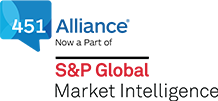
Source: S&P Global/S&P Global Ratings.
The industrial IoT landscape is evolving, but progress remains uneven. Results of a recent survey conducted by S&P Global Market Intelligence 451 Research shows that organizations are actively deploying IoT technologies, yet many remain in early or mid-stage maturity, with strategy and scale still developing. While digital transformation is widely embraced, the momentum is driven more by pragmatic goals such as cost savings and operational efficiency than by disruptive ambitions like competitive differentiation or full autonomy. Tracking return on investment is common, but expectations are measured, reflecting a cautious investment climate. Budget ownership is also shifting, with operational technology teams gaining influence alongside IT, signaling ongoing convergence of digital and physical domains. Meanwhile, interest in autonomous operations is high, but actual deployments remain limited, underscoring the complexity of scaling intelligent systems in industrial environments.
The Take
Even as industrial IoT matures, with a boost from growing doses of AI, vendors targeting industrial IoT and OT buyers must calibrate their approach around operational pragmatism. Adoption is widespread, but maturity remains fragmented — most deployments remain mid-stage, with strategy and scale still coalescing. Buyers are largely not pursuing disruption; they are chasing uptime, efficiency and measurable ROI. Autonomy is a long-term ambition, not a near-term reality, and digital twins are gaining traction as foundational enablers, not futuristic add-ons. Vendors should prioritize integration, interoperability and clear ROI pathways over visionary narratives. IT still holds significant budget, but OT’s influence is rising, and messaging must resonate with both groups. Use cases are shifting from visibility to control, and buyers are looking for tools that move beyond dashboards to decision support and automation. Above all, vendors must meet customers where they are (and indeed, where they have been since S&P Global Market Intelligence 451 Research began surveying OT leaders almost a decade ago): focused on outcomes, wary of complexity and demanding proof of operational impact.
Summary of findings
IoT adoption is real, but maturity is uneven. Nearly half of organizations (49%) report active IoT deployments beyond pilot stages, yet only 29% say their projects are in an advanced stage. This gap suggests that while IoT is widely adopted, many deployments remain in mid-stage maturity, with strategy and scale still evolving.
Top IoT drivers are cost savings and process optimization, not innovation. Cost reduction (42%) and operational efficiency (41%) are the leading motivators for IoT initiatives, while competitive differentiation and ESG goals rank lower. This suggests that most organizations still view IoT through a pragmatic lens rather than as a transformative lever.
Autonomy remains aspirational, despite strong interest. More than 85% of organizations express interest in autonomous operations, with 43% actively planning or deploying and another 44% exploring feasibility. Yet only 5% report full autonomy today, and just 15% operate at a semi-autonomous level. The disconnect between ambition and reality reflects the complexity of integration, cultural resistance and the need for clearer ROI, with each of these barriers cited by more than a third of respondents.
Digital twins are becoming central to OT strategy. More than 80% of utilities organizations plan to operate digital twin and digital thread processes within two years, with 38% aiming for full synchronization between physical systems and virtual models. These capabilities are increasingly viewed as foundational for predictive maintenance, simulation and real-time decision support, especially in asset-intensive sectors such as manufacturing and energy.
IoT use cases are shifting from visibility to control. While early IoT deployments focused on monitoring and data collection, organizations are now prioritizing use cases that enable optimization and automation.
In manufacturing, for example, 45% of respondents report implementing production monitoring, and nearly as many are deploying predictive maintenance (29%) and intelligent logistics (28%) — use cases that go beyond visibility to actively improve performance. Similarly, among oil and gas organizations, AI-based facility and process optimization is both a top current use case (32%) and the most frequently planned for future deployment (33%).
This evolution signals growing confidence in IoT as a tool for operational transformation, rather than just insight generation.
ROI tracking is widespread, but expectations vary. Notably, 87% of organizations track ROI on IoT initiatives, and among them, the median expected return is 38%. However, only 2% expect returns above 100%, indicating that while ROI is a priority, expectations are generally moderate and grounded in incremental gains.
IT still dominates IoT budgeting, but OT is gaining ground. IT departments are the primary budget contributors for industrial IoT in 48% of organizations, but OT departments follow closely at 32%. This signals a shift toward more balanced ownership between IT and OT, reflecting the convergence of digital and operational domains.
Want insights on IoT trends delivered to your inbox? Join the 451 Alliance.

